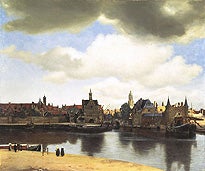Frick’s Vermeers
Reunited
Extended through November 23, 2008
After the deaths of van Ruijven and of
his wife, Maria, their picture collection was
inherited by their only daughter, Magdalena.
When she died in 1682, at the age of twenty-six,
the paintings came into the possession
of her husband, the Delft bookseller Jacob
Abrahamsz. Dissius. An inventory of Dissius’s
estate and property, drawn up the year after
Magdalena’s death, listed twenty Vermeers,
all of which Dissius had presumably inherited
from her. According to this document,
there were eleven Vermeers in the front
room of Dissius’s house on Delft’s Markt
(or “Market”); four in the back room; one
in the kitchen, which apparently also served
as a bedroom; two in a basement room; and
two elsewhere in the residence. The subjects
of the paintings in the Dissius home are not
specified in the 1683 inventory.
Six months after Dissius’s death, in
October 1695, an advertisement in an Amsterdam
newspaper announced an auction of “excellent artful” works, among them “21
pieces extraordinarily vigorously and delightfully
painted by the late J. Vermeer of Delft,
representing several compositions, being the
best he ever made,” all of which came from
Dissius’s collection. It is not known how the
number of Vermeers increased from twenty
to twenty-one between 1683 and 1695. It
is possible that the clerk who drew up the
earlier inventory accidentally ascribed one
of the paintings to a different artist, or that
Dissius added another Vermeer to the collection
that he had inherited from his wife.
| |
 |
|
|
| |
Vermeer, View of Delft, c. 1660–61, oil on canvas,
Mauritshuis, The Hague |
|
|
The so-called Dissius sale, a landmark
event in the history of Vermeer’s art, took
place in Amsterdam on May 16, 1696. The
twenty-one Vermeers brought a total of 1,503
guilders and 10 stuivers, then a substantial
sum. Not surprisingly, the top price of 200
guilders was paid for the stunning painting
described as “The Town of Delft in perspective, to be seen from the South, by J.
van der Meer of Delft”. Notably, the
three Vermeers now in the Frick all seem to
match descriptions of works that were sold
as part of this 1696 auction. Scholars agree
that lot 7 in the Dissius sale (“A young lady
to whom a letter is brought by a maid”) is
most likely the Frick’s Mistress and Maid. It
fetched a respectable 70 guilders. Lot 10 (“A
gentleman and a young lady making music
in a room”), which brought 81 guilders, is
probably the Frick’s Girl Interrupted at Her
Music. And, finally, lot 11 (“A soldier with a
laughing girl, very beautiful”), which went
for a relatively low 44 guilders and 10 stuivers,
is, in all likelihood, the Frick’s Officer and
Laughing Girl.
Who bought Jacob Dissius’s twenty-one
Vermeers at the Amsterdam auction remains
unknown, although it seems probable that
the works fell into many different hands. After
the sale, most of the paintings disappeared
from view for many decades, some for more
than two centuries. Vermeer, too, quickly fell
into oblivion; the fact that his oeuvre was
small also made it easier for his name to be
forgotten. After the Dissius sale, the Frick’s
Girl Interrupted at Her Music presumably
remained in Vermeer’s native country, where
it reappeared more than a century later at an
auction in Amsterdam in 1810. It went unsold
at 610 guilders. When the Girl Interrupted at
Her Music again came on the Amsterdam market, about a year later, it went for a low
399 guilders.
The Frick’s Mistress and Maid also resurfaced in 1810, at a sale in Paris, where
it was sold for 610 francs as “A Young Woman
Counting with Her Housemaid.” The Frick’s
Officer and Laughing Girl did not reappear
until 1861, when it was sold in London for
the impressive sum of £87.3. Like many other
Vermeers, the picture, by then, had lost its
proper attribution. It was listed in the London
sale as a work by “De Hooghe,” that is, Pieter
de Hooch (1629–1684), the genre painter
whose much-sought-after works fetched
extremely high prices all across Western
Europe during the eighteenth and nineteenth
centuries and whose reputation far surpassed
that of his contemporary and fellow townsman
Vermeer. About the same time, other
works by Vermeer were recorded under the
names of seventeenth-century Dutch artists
as diverse as Rembrandt and his pupil Govert
Flinck; the esteemed painters Gabriel Metsu
and Frans van Mieris; and lesser figures, such
as Jacob Vrel and Esaias Boursse.
Next page >> |


